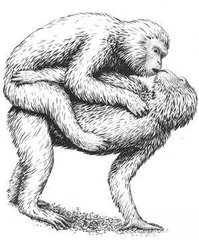And of course new revelations about heterosexual behavior are being made all the time: female initiation of mating activity in Orang-utans, for example, was not documented until 1980 in spite of nearly 22,000 hours of observation over the preceding 20 years (and prior extensive field studies often failed to report any heterosexual copulations). As recently as 1996, the existence of polygamous trios in the tanga’eo or Mangaia kingfisher (of the Cook Islands near New Zealand) were uncovered for the first time, and the full extent of heterosexual mating by Common Chimpanzees with animals outside their group was not understood until 1997. Multiple heterosexual matings by female Harbor Seals were not verified until 1998; even then, the behavior was never directly observed during three years of study (including continuous, 24-hour videotape surveillance of captive animals over an entire breeding season), and had to be verified indirectly through DNA testing. 36If direct observation by scientists were used as the sole criterion for the existence of a behavior, we would have to conclude that many species never engage in heterosexuality (or in certain forms of heterosexuality)—yet we know this cannot be true. So the fact that homosexuality has not been seen in many animals does not necessarily mean that it is absent in those species—only that it has yet to be observed.
Ironically, many species in which heterosexuality has rarely or never been observed are ones in which homosexual activity has been recorded. No information on the heterosexual mating system of wild Emus was available prior to 1995, for example, although homosexual copulation in the same species had been observed in captivity more than 70 years earlier. Heterosexual mating has never been observed in Black-rumped Flameback Woodpeckers—although homosexual copulation has—while some studies of Nilgiri Langurs, Harbor Seals, Northern Quolls, and Gray-capped Social Weavers failed to record any instances of opposite-sex mounting, although same-sex mounting did occur. Similarly, documentation of sexual activity between male Walruses—including photographs—preceded by almost a decade comparable descriptions and photographic evidence of sexual activity between males and females. In Acorn Woodpeckers—a species that regularly engages in same-sex mounting—only 26 heterosexual copulations were recorded in over 1,400 hours of observation devoted specifically to recording opposite-sex mating. Likewise, heterosexual copulations in Australian Shelducks (a species in which females sometimes form homosexual pairs) were observed only nine times during nearly a decade of study, and on only three of these occasions was a complete behavioral sequence involved. Because of the difficulty of observing heterosexual copulation, the mating system of Killer Whales is still poorly understood and, according to one scientist, “may never be known with certainty.” Homosexual activity in the same species has already been documented, although its study is also still in its infancy. 37Obviously, then, an activity can be part of the regular behavior of a species and still be completely missed by observers or documented only rarely, in spite of conscientious and in some cases exhaustive observational regimens (both in the wild and in captivity).
Scientists have often characterized homosexuality in animals as “extremely rare” or “quite common,” for example, or as occuring “regularly” or “infrequently” —often without any numerical or contextual information. Yet such statements are virtually meaningless without a common standard of measurement and an agreed-upon point of reference. In an attempt to standardize the evaluation of homosexual behavior, therefore, many scientists have collected quantitative information—usually tallies of particular behaviors (sexual, courtship, pairing, etc.). In a few cases, the difficulty of field observations has precluded the direct observation of both heterosexual and homosexual activity, and several innovative techniques have been developed to calculate the frequency of same-sex activity based on indirect measures. The sex of Gulls, for example, is often difficult to determine under field conditions, and in colonies that may contain tens of thousands of breeding pairs, the task of determining which couples are homosexual and which are heterosexual is a daunting one. However, once researchers discovered that lesbian pairs typically lay supernormal clutches, the frequency of same-sex pairs could be much more easily tallied by counting the number of nests with double the usual number of eggs. One ornithologist even developed a mathematical formula (see the beginning of this section) for estimating the total number of lesbian pairs in a population based on a sample of clutch sizes, taking into account same-sex pairs that lay smaller than supernormal clutches (or heterosexual pairs that lay larger than average clutches). 38Likewise, determining the sex of mating Dragonflies can be extremely challenging while the animals are still alive, since they copulate in flight. Scientists discovered, though, that insects (both male and female) usually suffer head injuries from being clasped by a male during mating. These injuries can easily be recognized and counted once individual Dragonflies are collected—revealing that an average of nearly 20 percent of males in 11 different species (and more than 80 percent of males in some species) experience homosexual copulations. 39
Even when quantitative information is available, assessments of frequency are often subjective and contradictory. For example, one scientist observed 24 homosexual copulations between Pukeko (7 percent of all sexual activity) and classified the behavior as “common,” while another zoologist observed nearly identical numbers and proportions of same-sex mounts in Pronghorns (23 mounts, 10 percent of all mounting activity) yet classified the behavior as “rare.” 40The problem is that there are many different ways of measuring and interpreting the frequency of same-sex behaviors. Besides tallying absolute numbers of particular activities or determining the proportion of all sexual activity that is homosexual, frequency rates and activity budgets can also be calculated, along with the percentage of the population that engages in same-sex activity. Frequency rate refers to the number of homosexual acts performed during a given time period, either by each individual or within a group of animals as a whole. For example, among Hanuman Langurs each female participates in a homosexual mounting, on average, once every five days, while in some populations of Ostriches courtship between males occurs at the rate of two to four times a day. An activity or time budget , on the other hand, refers to what proportion of an individual animal’s activity or time is devoted to homosexual interactions. For instance, a male Killer Whale spends more than 10 percent of his time interacting socially and sexually with other males; about 15 percent of courtship display time in male Regent Bowerbirds involves displaying to other males; more than a third of some male White-handed Gibbons’ time is devoted to homosexual interactions; while 10 percent of a male Crab-eating Macaque’s interaction with other males involves mounting activity. 41The percentage of the population that engages in homosexual activity varies widely, from only one or two individuals in a flock of several thousand Gulls, to virtually the entire population of male Bighorn Sheep, and everything in between. Of course, some of these individuals also engage in heterosexual activity (exhibiting various degrees of bisexuality), while others are more or less exclusive in their homosexual relations; this will be discussed in more detail in chapter 2, where the question of sexual orientation is explored.
Читать дальше












